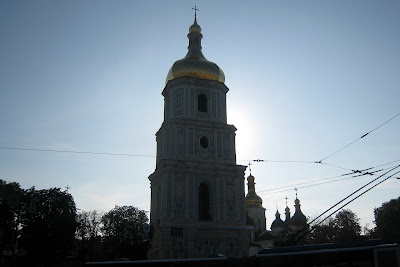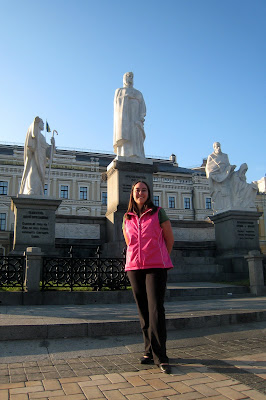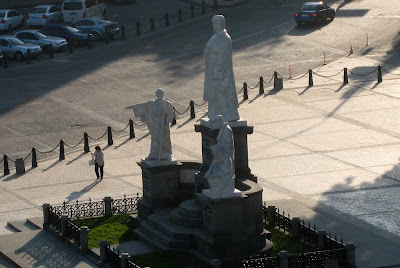Monday, August 31, 2009
Unforeseen Circumstances
A person wonders—what will my supporters think, will I be accepted upon arriving home (by more than my family), will I still be supported in my decision, will I be lifted up and encouraged during this difficult time in life. Or will I be ridiculed and looked down upon? Will people assume me as a failure or one who just couldn’t handle the “missionary life?”
God has called me here for a reason, and sometimes we do not know why, for years. Why did he bring me here for two weeks? I know I will come back; hopefully, sooner than later. “God, I want to trust you in every area of my life. I confess my pride concerning coming home. Thank you for your forgiveness. Amen.”
“My tears turned to tears of joy. Not because the pain was gone, but because I knew God was using me to reach His world. It’s not about me, but about Him. When you weep, whether from personal pain or disappointments, let God turn your tears of sorrow in to tears of joy, hope, love, and expectation for those around you. Let Him take your eyes off yourself. You may still cry tears, but they will be sweet tears—bittersweet tears.” Father, help me take my eyes off myself so that I can turn my eyes to the lovely face of Jesus. Amen.
As I was reading today, I found the best answer that I have ever heard concerning the question, “Where are you from or where do you live?” The answer, “It does not matter where I live or where I’m from, because Jesus lives in my heart.” No matter where I am, He is there with me. With Jesus in my heart, I’m at home anywhere.
The quoted paragraphs come from Beth Moore’s book, Voices of the Faithful.
I have been encouraged many times over by the people here at KCA and The Mission Society, my sending agency. People are concerned about me, and agree that it is a wise decision, to come home, for a period of time. The headmaster at the school said, “There is no shame in coming home.” I need to grasp that for myself and believe it in my heart.
I would covet your prayers, support, and encouragement, during this challenging and frustrating time. Prayer is our connection with God—and we know it works. Support—both physically and financially, as I am without work and I am trusting in Gods provision. Encouragement is vital; I am downtrodden.
Tuesday—25 August 2009
Wednesday I stayed home, as I was hoping to feel better the next day. Thursday, sadly, I was sick!
Teacher Orientation and Happy Independence Day

Jessica, Myself, and Jodi at teacher training--notice it's a private training, just the three of us. Monday was eventful. I received curriculum guides, textbooks, and other materials for the upcoming school year.

Fresh squash, onions, and mushrooms.

Pasta, fresh diced tomatoes, fresh diced peppers, and black olives with "salad" spices.

These are the spices I used. I have no clue what was actually in it, but I used the spices, a little salt (actually I used the brine from the olives), olive oil, and some vinegar to create this fabulous salad!
In the evening, Masha, Vala, and I went out on the town, to celebrate Independence Day. I thought it was cool that people were hanging flags out of their balcony!


A Ukrainian artist singing in English—“Sweet, sweet baby, there is none other, you’re my only lover.”



Myself on the war exhibition.


At a concert hall.


Friendship Arch. The People’s Friendship Arch (Ukrainian: Арка Дружби Народів) dedicated to the unification of Russia and Ukraine, was constructed in Kiev, the capital of Ukraine. The Friendship Arch was constructed in 1982 by by sculptor A. Skoblikov and Architect I. Ivanov and others. It is 50 metres in Diameter, rainbow-shaped arch, made of titanium. It is called "The Yoke" by Kievans. Underneath the Friendship Arch there are two statues. One which is made of bronze and depicts a Russian and Ukrainian worker holding up The Soviet Order of Friendship of Peoples. The other is made from granite and depicts the participants of the Pereyaslavska Rada. of 1654.




Dnieper River and nice view.


Port a potty line-up. Although, I saw just as many people use the bushes.



Random Birdhouse on the street. The two people you can hardly make out are my roommates, Masha and Vala.

Putting my ticket in at the Metro.

Pretty art at the Metro station.

Looking out our kitchen window in our apt. you will see a bench. There is always someone or a group of people sitting here. Behind the bench is a basket ball court and multiple playgrounds. I love it! :)

Copecs--Ukrainian change!
Sunday—23 August 2009
Church was in Russian and Ukrainian, although, since there was a large number of English speakers—10 or so, when we broke into smaller groups, I was in the English group, there were two Ukrainian groups, and a children’s group. Instead of a sermon, we had small group discussion. I did not get the impression that it was normal, but I did enjoy hearing what other people had to say about the scripture being discussed—Zaccheus. We were then encouraged to share our testimony with at least one person this week. I received an F on my homework assignment.
In the evening, Masha, Jodi, and I went to downtown Kiev. Jodi is another teacher, from America. Masha and I met Jodi at the International Restaurant—McDonalds. From there we went back onto the Metro and explored downtown.
Masha and I at the Metro station. I would have deleted the pic where my eyes are closed, but I wanted to show the train, behind us. Thus, I kept the photo.




A government building. There were lots of important people here the evening that we visited. Everything was blocked off and you could only take pictures from a distance.








St. Michael’s Cathedral.





The carillon bells that play hourly at St. Michael's. At noon and midnight the national anthem is played.





Apostle Andrew, Olga princess Monument, and Saints Cyril and Methodius (the founders of the Slavic alphabet and literacy, hence the term the Cyrillic alphabet).
Russian is written in the Cyrillic script. It was created in the 9th century by the Saints Cyril and Methodius, two brothers born in Thessaloniki. The alphabet originally contained 43 letters - 24 of them based on the Greek alphabet. Written Russian grew out of the Slavonic writings of the Church. Today the Russian alphabet has 33 letters.
The woman statue in the middle is of Olga (945-962), she was one of the quiet Christians in Kiev history. Olga, the wife of Ihor, was depicted as being beautiful, vigorous, crafty, and above all, wise. She was given the ultimate compliment by a male chronicler informing his readers that she was "manly of mind." Vengeance was the moral prerogative of the time, Olga quickly and effectively avenged herself on her "enemies."
Olga introduced the first "reforms" in Kievan Rus' (early Kiev) establishing clearly demarcated areas from which specified amounts of tribute were to be collected at regular intervals. She also saw to it that her subjects were not deprived of all their sustenance to ensure that they would be in a position to pay tribute again. To familiarize herself with her vast domain, Olga made numerous and extensive trips to all its major town and regions. Her foreign relations were characterized by diplomacy, not war. Olga was accepted as a negotiating partner by Constantinople, the mightiest ruler in Christendom--this is a reflection of Kiev's growing importance.


The fountain of tears. This is a reproduction. In the case of the Crimean Khan that ruled the region between 1758 and 1764, a Fountain of Tears marks the passage of his ancient journey through the common experience of grief in the Crimean city of Bakhchysaray.
According to legend, the last Crimean Khan, Giri, fell in love with a beautiful Polish woman who had been captured and brought to his harem. Perhaps due to the anguish of her imprisonment or maybe as a result of a murderous plot to poison her, the Khan's paramour died unexpectedly. When the fearless ruler and warrior became paralyzed by grief, his court ordered a Persian master craftsman to construct a fountain to mark the Khan's distress.
Legend guides the meaning of the fountain. The marble flower, symbolizing the Khan's eye, fills the top cup of the fountain, the ruler's heart, with grief and sorrow. A pair of smaller cups speaks to time assuaging the pain, a pain that is later revived by the large cup in the middle suggesting memory. The pilgrimage of grief is relieved by eternity, signified by the spiral at the bottom of the fountain. Originally constructed over the young woman's tomb in a quiet garden, the Fountain of Tears was relocated to its present location in the courtyard of the Khan's Palace after Catherine the Great ordered the annexation of the Crimean region.


Pretty orthodox church.


One of the markets, many artists come to this street to sell their paintings and handy-crafts.


The long street, made with cobblestone and brick.








